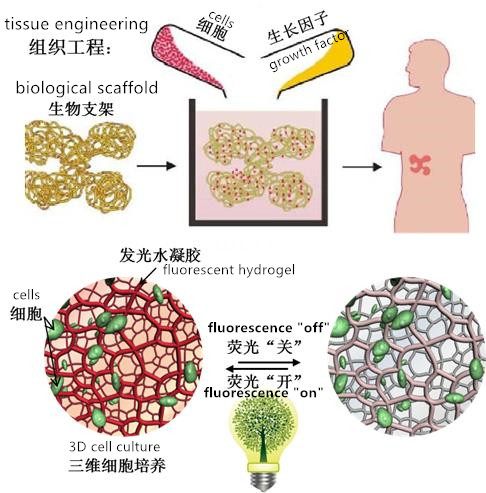Earthworms can revive from half cut bodies, geckos are capable of growing new tails and the starfish succeeds in repairing any part of its body. The amazing ability of self-repair demonstrated by these animals is something human beings crave but can only achieve by tissue engineering techniques, the key to which lies in cell culture matrix materials that help repair and reconstruct damaged human bodies. According to the source at Tianjin University in April, Professor Yang Dayong led his team and created a novel fluorescent hydrogel that realizes reversible “On/Off” fluorescence of matrix during the observation of 3D cell culture system. The research paper was published in the international journal Advanced Science and relevant techniques are applying for invention patents in China.

The fluorescent hydrogel realizes reversible “On/Off” fluorescence of matrix during the observation of 3D cell culture system.
At present, scientists mainly rely on the 3D cell culture matrix technique to reconstruct human tissues and organs, for example man-made ears and noses that are exact in shape and naturally soft in texture. “If we compare a cell to a seed, then the novel hydrogel we developed is like the fertile soil that provides sound base and abundant nutrients that are necessary for the seed to grow. Meanwhile, it can provide a fluorescent environment that better facilitates the observations of seed growth.” Professor Yang introduced. The fluorescent hydrogel is nontoxic and biocompatible, proving to be an excellent 3D cell culture matrix. It is worth mentioning that this hydrogel exhibits a rapidly reversible “On/Off” fluorochromic response to external ion stimulation that doesn’t affect cell growth. When the fluorescence is on, it helps verify the position of cells in the matrix; when off, it eliminates the background fluorescence and makes it easier to observe the multi-stained subcellular structures.
This new material is believed to have great potential in biomedicine. It can be used as a fine cell culture matrix for the 3D culture of stem cells since it provides cells with a micro-environment that is very similar to living conditions within the human body. It makes tissue repair and organ regeneration more promising, bringing new hope for improving the health of human beings.
By Eva Yin
Editors: Doris Harrington






